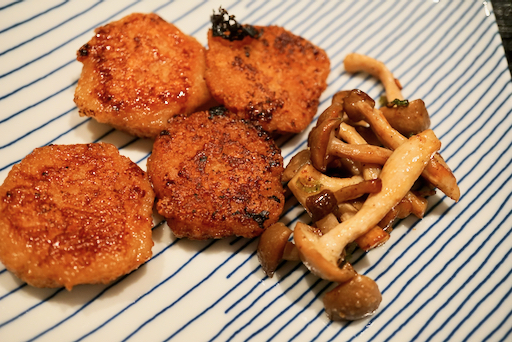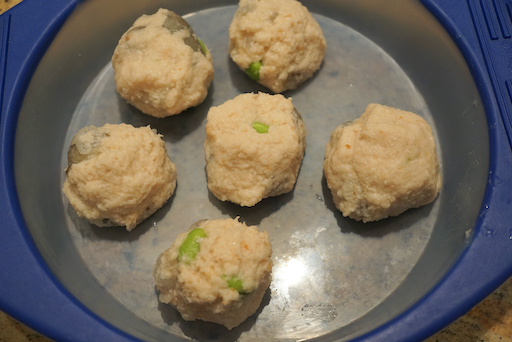Once we got used to having a Sushi Taro Osechi Box, it is difficult to cerebrate New Year's without one. We started getting the
Osechi box from Sushi Taro in 2012.
This is the top box. It was nicely packed with all kinds of goodies. I just wanted to share the excitement we had enjoying this box and provide some trivia concerning Japanese "Osechi" dishes. These Japanese New Year's dishes are traditionally prepared as auspicious dishes to have at the beginning of the year. They are for the family to eat during the first 3 days of the year which are considered the most auspicious and are called ”Shogatsu Sanganichi" 正月三が日.
Each of the dishes through their color, shape and number, among other things have symbolic celebratory meaning often in multiple layers or as puns/plays on words. For example, red combined with white is considered an auspicious color combination. Thus, red and white is a traditional color motif for New Year's dishes as exemplified by the red and white fish cakes (#2 in the annotated picture below). Red snapper is an example of a dish that has multiple layers of symbolic meaning; not only does it incorporate the venerable color red but also includes a play on words because it is called "Tai" which in Japanese rhymes with "Omede-tai" おめでたい commemorating "celebration" (#6). Many small fish and roe are symbols of prosperity and numerous offspring and are represented multiple times through out these boxes by such things as salmon, cod, mullet and herring roe. Herring roe incorporates an additional layer of meaning since it is also "gold" in color and gold would be considered the color of fortune in almost any culture. Dishes rolled in kelp represent a pun on words since "kelp" or "Kobu" rhymes with "Yoro-kobu" 喜ぶ which means "to rejoice". So cod roe wrapped in kelp (#17) incorporates the symbolism of numerous offspring and rejoicing. Black "kuromame" beans are eaten because "beans" in Japanese are called "mame" 豆 another play on words because it sounds similar to the word which means being "attentive, truthful, and helpful". (All this symbolism gets complicated but the degree of thought that goes into the choice of these particular dishes becomes evident). All these auspicious foods are thought to set the tone for the upcoming new year. Of course, many of these dishes are great with sake which flows more readily during New Year and what would a celebration be without it?

1. Kuromame 黒豆 black beans, 2. red and white fish cake "Kamaboko" 紅白蒲鉾 3. Bottarga "Karasumi" 唐墨 (our favorite!) 4. "
Jako" hatchling fish simmered in "Sansho" 山椒 Japanese pepper flavor 雑魚の有馬煮 (In a plastic container wrapped in white paper) 5. Pickled "renkon" lotus root cut in a decorative flower shape 花輪酢蓮根 6. Grilled whole small red snapper "tai" 子鯛姿焼 7. Stem lettuce or celtuce marinaded in miso チシャトウ西京漬け (this is new this year. Crunchy and sweet miso flavor is nice) 8. Soy sauce marinated salmon roe いくら醤油漬け 9. Daikon julienne picked in sweet vinegar 錦なます.

10. Herring roe marinated in miso 数の子味噌漬け 11. Mustard stuffed burdock からし牛蒡 (our favorite, the best way to enjoy gobo as far as we can tell) 12. Steamed sea urchin 蒸しウニ 13. Steamed fish cake with matsutake mushroom 松茸真蒸 14. Simmered small whole shrimp 小海老艶煮 15. Burdock root in sesame dressing たたき牛蒡 17. Cod roe wrapped in kelp タラコの昆布巻き 18. Kumquats simmered in syrup 金柑蜜煮 19. Simmered chestnuts with brown skin 栗の渋皮煮 (We had inside information that these are North American chestnuts and only the ones without deep creases are chosen for this dish) and underneath are "scallop braised in sweetened soy" ホタテの甘煮.
"
Karasumi" is our favorite and really encourages sipping sake with each nibble. This was prepared in house at Sushi Taro. We like the Japanese preparation of this, especially Sushi Taro's, as compared with Bottarga from Italy. As previously mentioned, the Japanese preparation goes especially well with sake. Although not the best with sake, grated on the pasta, Bottarga is mighty fine.
Of course, ikura salmon roe marinated in soy sauce is another dish that goes so well with sake.
I made
salmon kelp roll this year and this dish is similar but uses cod roe "tarako" wrapped in kelp instead of salmon. It was a very nice variation.
Of course, raw sea urchin is the best but steaming is a good way to make sea urchin last longer.
Small red snapper is peaking through.
This is the bottom box.
1. Monk fish liver terrine あんきも豆腐 (Another of our favorites) 2. Mashed sweet potato with chestnuts 栗きんとん 3. New Year Omelet roll 伊達巻 4. Pickled renkon with decorative flower cut 花輪蓮根 5. Yellow tail sushi wrapped in picked turnip 鰤かぶら寿司 6. Grilled pompano marinaded in sweet miso まながつお西京味噌焼 7. Steamed head-on prawn 長寿海老 (this is the first time we had head on prawns. The bent "back" of the shrimp symbolizes longevity as represented by the bent backs characteristic of the venerable elderly in Japan in the old days) 8. Grilled Japanese snapper with "kinome" miso paste 真鯛の木の芽焼き 9. First spring harvest bamboo shoot 新筍土佐煮 10. Duck breast teriyaki 鴨照り焼き and other wonderful simmered vegetables. I think I may have left out a few items.
The prawns were really good with firm texture and sweet taste. Since these were head-on prawns, we could "suck" out the tamale from the head (which we did).
The grilled fish was best heated up in the toaster oven before enjoying. "Kinome" miso (green stuff) has a very distinctive flavor. This is the young shoot (leaves) of Japanese "sansho" (or Chinese) pepper tree.
The duck breast was great. I think that, underneath the duck, there may have been small dumpling made of edible lily bulb and grated renkon.
These vegetables are good but especially unique is "
Kuwai" くわい, best seen bottom right, which is an unusual vegetable for Westerners and has very interesting texture. This is mostly served as a New Year dish because of the shape, it was equated with "me-ga-deru" 芽がでる meaning "sprouting" that sounds like "me-de-tai" めでたい meaning "auspicious' or "celebratory", another "pun".
In any case, I may have gone on longer than I probably should have but I just wanted to convey what a joy it is to delve into these boxes. All the multiple layers of symbolism and meaning entailed in these celebratory New Year's dishes are given justice through the attention to detail and careful execution by the chefs at Sushi Taro making it especially memorable. Luckily, we will be feasting on these boxes for some days to come.


























































